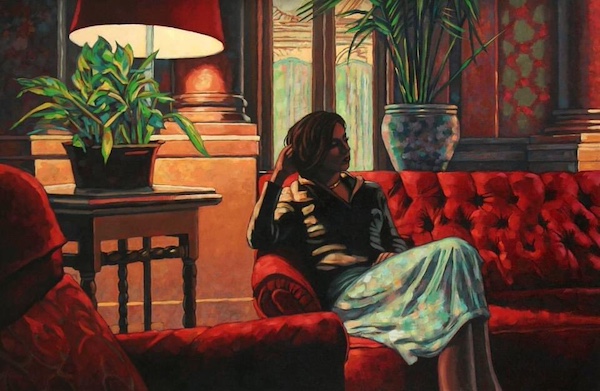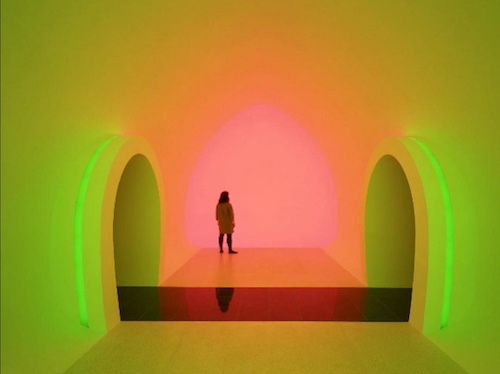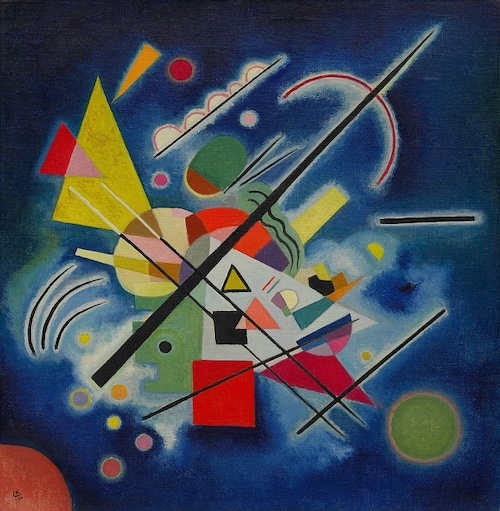Tags
#CarisReid, #EmilyDickinson, #GeorgeHerbert, #KathyEngel, #MarkHarrison, #MaryRuefle, #MichałPrażmo, #MilesHyman, #PoetryPrompt, #TawadaYoko, art, Kandinsky, Paintings, Possibility
In the universe, there are things that are known, and things that are unknown, and in between them, there are doors.
William Blake

My dear fellow poets, I’m Dora @PilgrimDreams.com. Welcome to the dVerse Poets Pub, this boldly creative hub and liminal space. Why a liminal space, you ask? Well, because it is an “in between” place, a passage with many doors which we traverse to get to one another, from one blog to another, one poem to another.

The word liminal comes from the Latin root limen which means “threshold.”
In general, a liminal space can be looked at in three ways:
1) as an empty structural space (an overgrown, ruined fairground, shuttered department store once familiar like K-Marts here in the U.S., an abandoned shopping center or mall, a silent nighttime hotel corridor); OR
2) as a place of transit (a hotel lobby, an airport terminal, or a parking garage, gas/petrol station or a city street at night); OR
3) a passage in a more abstract sense, e.g., New Year’s Eve, a decade’s close, a birthday, anniversary, or holi(holy)day.
As you think on these liminal spaces, ask yourself this: is a poem like a liminal space?

A liminal space sharpens our senses to the possible.
If you’ve been in an empty parking garage or hotel corridor at night, perhaps you’ve felt an inchoate threat, a frisson of fear, a heightened sense of your vulnerability, or at the very least, an eerie loneliness. On the other hand, once you’ve passed through security at a crowded airport and arrived at your terminal, you can relax in your anonymity and explore your surroundings freely. Both types of spaces can cause anxiety or curiosity or a mixture of both.
The Japanese German bilingual poet Tawada Yōko feels free to explore his temporary comradery with men in the liminal space of a train platform. The lyrical voice empathizes and observes, at once present and disconnected.1
Cigarette? (excerpt)
Next to this old guy I want to stay for a while
Smoke going cold
bitter
the burnt smell of dried-up men
gathering who fled from the salty moisture of diapers
[…] dry like the ink of yesterday’s newspaper
the back of the nose hurts
the platform is‚ my ‘home’
giant iron, the train rolls in
iron double doors open
to summer‘s fresh batch
of boys […]
even if they laugh at him
he does not lift his eyes
from the exchange of loving gazes with his cigarette
The old guy with the earthen face
next to whom I
just for a little while longer
want to sit.
No doubt there is a certain amount of traveling blues jumbled with awkwardness and alienation going through such spaces.
In “It would be water” by Kathy Engel, the liminal space is prized for its anonymity, but gives way to what the poet in her marginal notes describes as:
The alone and the not alone. The ongoing. When and how one can or can’t show up in the way one hopes to. The liminal space between what we call living and what we call dead. What poems offer.
Liminal architectures give us room to experience or observe moments of conjoining or leave-taking which otherwise remain obscured. Atmospherically, empty structural spaces like midnight hotel hallways and city streets (see painting above by Mark Harrison) or abandoned fairgrounds and shuttered K-Marts are far more surreal and unsettling than a place of transit.
But a liminal space can also act as a womb, a safe place from which to absorb and anticipate the eventual departure and arrival of life’s inevitable movements, preparatory to embracing them.

At a Motel Near O’Hare Airport by Jane Kenyon
I sit by the window all morning
watching the planes make final approaches.
Each of them gathers and steadies itself
like a horse clearing a jump.
I look up to see them pass,
so close I can see the rivets
on their bellies, and under their wings,
and at first I feel ashamed,
as if I had looked up a woman’s skirt.
How beautiful that one is,
slim-bodied and delicate
as a fox, poised and intent
on stealing a chicken
from a farmyard.
And now a larger one, its
tail shaped like a whale’s.
They call it sounding
when a whale dives,
and the tail comes out of the water
and flashes in the light
before going under
Here comes a 747,
slower than the rest,
phenomenal; like some huge
basketball player
clearing space for himself
under the basket.
How wonderful to be that big
and to fly through the air,
and to make so great a shadow
in the parking lot of a motel.
In his poem “Now,” Denis Johnson speaks of the poet’s relation to the liminal, this “space between spaces,” a space that is defined only by its in-between state “where nothing speaks,” “a space without territory” (“espace sans terri-toire”) as the philosopher Jacques Derrida puts it.2
Now (excerpt)
I am here at the waters
because in this space between spaces
where nothing speaks,
I am what it says.
—Denis Johnson, “Now,” (lines 46-50), 1995
For contemporary poet Mary Ruefle, a liminal space is the “museum of everyday life,” tucked in the larger space of weeks, months and years.
Inglenook by Mary Ruefle
I live in the museum of
everyday life,
where the thimble is hidden
anew every week and often
takes five days to find.
Once it was simply lying
(laying?) on the floor
and I missed it,
looking inside my mouth.
A grease fire in the inglenook!
That took a lot of soda!
Free admission, but guests
are required to face-wash
before entering and
tooth-clean before leaving.
Open daily, the doorknobs
are covered with curated
fingerprints, and pass
on the latest news.
George Herbert, the 17th-century metaphysical poet, describes the elements of sacramental Communion (bread and wine) as a familiar yet enigmatic passageway – a liminal space – through which grace enters the soul.
The H. Communion (excerpt)
Onely thy grace, which with these elements comes,
Knoweth the ready way,
And hath the privie key,
Op’ning the soul’s most subtile rooms:
While those to spirits refin’d, at doore attend
Despatches from their friend.
So can a poem itself be a liminal space? Perhaps, as Engel says above, it can be one of the things a poem offers.
We began by saying that a liminal space sharpens our senses to the possible. In the following poem, Emily Dickinson designs one composed entirely of possibility, a transformative one.
I dwell in Possibility –
A fairer House than Prose –
More numerous of Windows –
Superior – for Doors –
Of Chambers as the Cedars –
Impregnable of eye –
And for an everlasting Roof
The Gambrels of the Sky –
Of Visitors – the fairest –
For Occupation – This –
The spreading wide my narrow Hands
To gather Paradise –
Our challenge? Using one of the three types of liminal spaces listed above, let’s give poetic voice to what “doors” it may open to us. You can employ the liminal space as the setting and/or the subject. Write about it as an observer or participant, of how it may prepare, ground, provoke, intrigue you, unexpectedly or not, for better or worse. You may want to use an image (like those above) for inspiration. I just want you to have fun exploring the idea of a liminal space and seeing what you can come up with.
New to dVerse? Here’s how to join in:
* Write a poem in response to the challenge.
* Post your poem on your blog and link back to this post.
* Enter your name and the link directly to your actual post (not your blog or website) by clicking Mr. Linky below (remember to check the little box to accept the use/privacy policy).
* You will find links to other poets and more will join, so please do check
back later in order to read their poems.
* Read and comment on your fellow poets’ work– there’s so much to derive from reading each other’s writing: inspiration, new approaches, new friends.
* Enjoy!








Welcome everyone! The dVerse pub doors are open!
Courtesy of The Overlook Hotel (via Stanley Kubrick’s The Shining), Lloyd the bartender is on loan to offer whatever you desire from his late-night bar menu, including coffee, tea and desserts.
See you in the liminal spaces!
Hi Dora. Love the prompt. A warm chocolate for me please. I look forward to reading the poems.
Glad to see you, Grace! Warm chocolate coming right up.
Good evening from the UK Dora – the scope of your prompt is immense and there are so many concepts in the poetry and images you have posted here – thank you for launching our poetry over the threshold!
Haha! “Launching” indeed.Thank you so much Laura. My problem was knowing when to stop!
This prompt was a bit daunting at first… but I say like Hermione Granger… whenever in doubt, go to the library.
It worked like MAGIC for you, as always!
Really excellent work on this challenge, Dora, a gift of so many hidden doors for the community. You rock.
You made my day, Brendan. Thank you! Can’t wait to see what passage you choose, what door you open to us.
What wonderful poetry you shared today Dora! And thank you so much for hosting. This is going to be an enjoyable, prompt great choice! 🙂✌🏼🫶🏼
Thank you, Rob. If it’s inspired you, I’m so pleased and grateful! 🙂
hi dora
hi poets,
can I have a double shot of RED RUM, RED RUM.
sorry had to get a shinning reference in love the book and the film.
I enjoyed the prompt.
catch up when I can
two live poetry sharing evenings coming up
rog
Haha! Lloyd is at my elbow even now as I write. Get to it, Lloyd! I love that movie too — but Kubrick — what a gift for unforgettable shots! Speaking of which, here’s Lloyd with yours. 🙂
Rog’s Red Rum made me laugh!
Mine is an extended cinquain and is, well, weird……. I may need a couple glasses of wine. Please.
Weird? Welcome to the space between spaces and a virtual bar with Lloyd serving up two shiny glasses of red wine. Weirdness welcome here. 🙂
I replaced the link with this one, for some reason, Medium is being a pill:
https://nolchafox2.wixsite.com/nolcha-s-written-wor/post/out-of-reach
Thank you!
Thank you for the prompt, Dora! I feel like I write about liminal spaces a lot, so I had to decide which way I wanted to go.
On a summer day, is it better to sit inside, or outside overlooking the maze? Gulp. Maybe I’ll take a drink to go. 😂. (My older child and their wife went there once–a tour, I think, but not overnight.)
Overlooking the maze, what an idea! I suddenly pictured Jack’s frozen face. UGH. I think it’s the Stanley Hotel, and it must have really made a big impression on Stephen King. We saw the opening scene of Kubrick’s film at an IMAX theater, and I must say, it makes a difference, the sweep of it, the music, all coming together to emphasize the stark isolation of the “Overlook” in the winter.
I think the IMAX version would have been too much for me! I read the book when it first came out. . .alone in the apartment with the snow beginning to fall . . .
😱 Now that was brave!
😅
Will be back later to read, folks! Lloyd is still around to take your orders. 🙂
A very interesting challenge, Dora. Thank you for hosting this evening. I will have to think on this one for a while before writing. An Ice Cold Cider would be wonderful!
An ice cold cider for those hot southern nights, Dwight, and I think I’ll join you! Cheers, my friend.
Wonderful!
Oooh, this is so interesting, Dora. I have an idea which I think works for this challenge. I’ll have a cup of Twinings apple, raisin and cinnamon tea.
I’m thrilled! Looking forward to reading it shortly. 😊 That cup of tea sounds really good, Robbie. I think I’ll join you in one as my afternoon on the dVerse trail gets going. Cheers!
I have written it and will post it a bit later today. This is delicious tea.
Lloyd–was that his name, Dora? No, I prefer you as bartender… I’ll have a lemonade, thanks.
I scheduled mine to go out in few hours. I’ll post link to Mr. Linky after it goes live. Wow, your prompt made me think. Think so hard. I did a little reading and researching and managed something. I hope you like it.
Only thing with me, I cannot seem to know how to shorten things. Even after all the practice, I still rattle on. Anyway, you will see.
Get Lloyd away from me, I cannot handle that… I’m wimpy that way. Thanks. Bless you.
Here’s a tall glass of lemonade. Cheers! Lloyd is on leave as of this minute, Selma! All the comradery in this space is just too much for an unsavory character like him.
I know you’ve spun something good for us and however long, it’ll be a treat! Blessings, dear Selma!
Phew, thanks for dismissing Lloyd. 🤗
😂💖
Late to the pub as usual but Tuesday to Thursday is my working week so I squeezed this one in before work – a moment observed some years ago and which has never left me.
I will have a coffee before work please Dora…
You’re probably home from work by now, Andrew! It’s so good to see you here, and the Poetics pub is open till Thursday 3 PM (EST) so you weren’t late at all. 😊 Oh and here’s a coffee for ya! Cheers!
Oh what a rich artery into the liminal, Dora!
In your topic and your exemplary quoted inclusions, you gather up several of my own remembered dwell-ings around the Place of the Threshold.
And as some writers have spoken of the Thin Places, I’d like to pad my own thin and hungry bones this chilly noon (in UK) by some hot soup (currently on the stove bubbling away), some buttered toast with Marmite, and a latte. No Kubrick bartenders required this end! But do have whatever you fancy, on me!
Haha! You’re not the first to express displeasure with His Creepiness. Just so you know, he’s on extended leave, that is, permanent retirement!
I’m so glad you enjoyed the prompt, Kathy, and as far as what’s cooking your way, I think I’ll pop on over to your space via the dVerse Pub-way and join you shortly!
just heating up leftovers for supper – enough for two!
🙌🤗💞
An interesting prompt, Dora. Thanks for hosting. I enjoyed the poems you shared. 🙂
Thank you! So glad you could join us, Aishwarya! 💖
Hi Dora, everyone, I love the resource and the prompt.
Good to see you, Paul. I’m thrilled you liked the prompt. Thank you!
Thank you for such a stimulating and challenging prompt. Is so interesting to have such profound stuff. like it v much. A renewed apology for my commentless blog. I honestly am not trying to be a bother.
So wonderful that you are here with us, Ain, in the dVerse Pub. Don’t worry about the commentless feature. I think folks want to express their appreciation but it’s not always possible to reply and that’s all too understandable. Thank you for sharing your words and your heart with us. 🙏🏽❤️
Such another cool prompt! Thanks for a stimulating reflection on liminality, Dora, and looking forward to reading everyone else’s contributions 🙂
Thank you, Chris! So good to see you here. Heading over to your space now. 😊
P.S. What a pleasure it was to read your poem!
A wonderful challenge, Dora! Not sure if you’ll see this comment or my poem since I’m too late for the link, but I was inspired by this. 🙂
I hope you link it to this post, Jen and seeing as we’re in a liminal space here between now and the beginning of next week 🙂, I’ll enter it in Mr. Linky. Looking forward to reading shortly!
Thanks very much, Dora!
Love all the illustrative artwork you’ve selected for the prompt
That makes quite happy. Thank you!